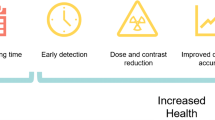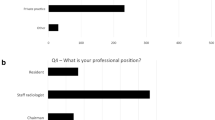Abstract
Artificial intelligence is a technique that holds promise for helping radiologists improve the care of our patients. At the same time, implementation decisions we make now can have a long-lasting effect on patient outcomes. In the following article, we discuss four areas with unique considerations for implementation of AI: bias, trust, risk, and design. In each section, we highlight applications of AI to abdominal imaging and prostate cancer specifically.
Similar content being viewed by others
References
Chartrand G, Cheng PM, Vorontsov E, Drozdzal M, Turcotte S, Pal CJ, Kadoury S, Tang A (2017) Deep Learning: A Primer for Radiologists. RadioGraphics 37:2113–2131. https://doi.org/10.1148/rg.2017170077
Kahn CE (2017) From Images to Actions: Opportunities for Artificial Intelligence in Radiology. Radiology 285:719–720. https://doi.org/10.1148/radiol.2017171734
Erickson BJ, Korfiatis P, Akkus Z, Kline TL (2017) Machine Learning for Medical Imaging. RadioGraphics 37:505–515. https://doi.org/10.1148/rg.2017160130
Sterne J, Savović J, Page M, Elbers R, Blencowe N, Boutron I, Cates C, Cheng H-Y, Corbett M, Eldridge S, Hernán M, Hopewell S, Hróbjartsson A, Junqueira D, Jüni P, Kirkham J, Lasserton T, McAleenan A, Reeves B, Shepperd S, Shrier I, Stewart L, Tilling K, White I, Whiting P, Higgins J RoB 2: a revised tool for assessing risk of bias in randomised trials. BMJ
Burns PB, Rohrich RJ, Chung KC (2011) The Levels of Evidence and their role in Evidence-Based Medicine. Plast Reconstr Surg 128:305–310. https://doi.org/10.1097/PRS.0b013e318219c171
Daugherty Stacie L., Blair Irene V., Havranek Edward P., Furniss Anna, Dickinson L. Miriam, Karimkhani Elhum, Main Deborah S., Masoudi Frederick A. (2017) Implicit Gender Bias and the Use of Cardiovascular Tests Among Cardiologists. Journal of the American Heart Association 6:e006872. https://doi.org/10.1161/JAHA.117.006872
Lyell D, Coiera E (2017) Automation bias and verification complexity: a systematic review. J Am Med Inform Assoc 24:423–431. https://doi.org/10.1093/jamia/ocw105
Fenton JJ, Xing G, Elmore JG, Bang H, Chen SL, Lindfors KK, Baldwin L-M (2013) Short-term outcomes of screening mammography using computer-aided detection: a population-based study of medicare enrollees. Ann Intern Med 158:580–587. https://doi.org/10.7326/0003-4819-158-8-201304160-00002
Lehman CD, Wellman RD, Buist DSM, Kerlikowske K, Tosteson ANA, Miglioretti DL (2015) Diagnostic Accuracy of Digital Screening Mammography With and Without Computer-Aided Detection. JAMA Intern Med 175:1828–1837. https://doi.org/10.1001/jamainternmed.2015.5231
Fenton JJ (2015) Is It Time to Stop Paying for Computer-Aided Mammography? JAMA Intern Med 175:1837–1838. https://doi.org/10.1001/jamainternmed.2015.5319
Challen R, Denny J, Pitt M, Gompels L, Edwards T, Tsaneva-Atanasova K (2019) Artificial intelligence, bias and clinical safety. BMJ Qual Saf bmjqs-2018-008370. https://doi.org/10.1136/bmjqs-2018-008370
Heaven D (2019) Why deep-learning AIs are so easy to fool. Nature 574:163–166. https://doi.org/10.1038/d41586-019-03013-5
Amodei D, Olah C, Steinhardt J, Christiano P, Schulman J, Mané D (2016) Concrete Problems in AI Safety. arXiv:160606565[cs]. https://doi.org/arXiv:1606.06565
Finlayson SG, Bowers JD, Ito J, Zittrain JL, Beam AL, Kohane IS (2019) Adversarial attacks on medical machine learning. Science 363:1287–1289. https://doi.org/10.1126/science.aaw4399
Sheridan TB (2019) Individual Differences in Attributes of Trust in Automation: Measurement and Application to System Design. Front Psychol 10:. https://doi.org/10.3389/fpsyg.2019.01117
Sheridan TB (1988) Trustworthiness of Command and Control Systems. IFAC Proceedings Volumes 21:427–431. https://doi.org/10.1016/S1474-6670(17)53945-2
Haidt J (2013) The Righteous Mind: Why Good People Are Divided by Politics and Religion, Reprint edition. Vintage, New York
Chan S, Siegel EL (2018) Will machine learning end the viability of radiology as a thriving medical specialty? BJR 92:20180416. https://doi.org/10.1259/bjr.20180416
Langlotz CP (2019) Will Artificial Intelligence Replace Radiologists? Radiology: Artificial Intelligence 1:e190058. https://doi.org/10.1148/ryai.2019190058
Miotto R, Wang F, Wang S, Jiang X, Dudley JT (2018) Deep learning for healthcare: review, opportunities and challenges. Briefings in Bioinformatics 19:1236–1246. https://doi.org/10.1093/bib/bbx044
Choy G, Khalilzadeh O, Michalski M, Do S, Samir AE, Pianykh OS, Geis JR, Pandharipande PV, Brink JA, Dreyer KJ (2018) Current Applications and Future Impact of Machine Learning in Radiology. Radiology 288:318–328. https://doi.org/10.1148/radiol.2018171820
Kohli M, Prevedello LM, Filice RW, Geis JR (2017) Implementing Machine Learning in Radiology Practice and Research. American Journal of Roentgenology 1–7. https://doi.org/10.2214/AJR.16.17224
Center for Devices and Radiological Health (2020) Artificial Intelligence and Machine Learning in Software as a Medical Device. FDA
Chilamkurthy S, Ghosh R, Tanamala S, Biviji M, Campeau NG, Venugopal VK, Mahajan V, Rao P, Warier P (2018) Deep learning algorithms for detection of critical findings in head CT scans: a retrospective study. The Lancet 392:2388–2396. https://doi.org/10.1016/S0140-6736(18)31645-3
Prevedello LM, Erdal BS, Ryu JL, Little KJ, Demirer M, Qian S, White RD (2017) Automated Critical Test Findings Identification and Online Notification System Using Artificial Intelligence in Imaging. Radiology 285:923–931. https://doi.org/10.1148/radiol.2017162664
Liu K, Li Q, Ma J, Zhou Z, Sun M, Deng Y, Tu W, Wang Y, Fan L, Xia C, Xiao Y, Zhang R, Liu S (2019) Evaluating a Fully Automated Pulmonary Nodule Detection Approach and Its Impact on Radiologist Performance. Radiology: Artificial Intelligence 1:e180084. https://doi.org/10.1148/ryai.2019180084
Tian J, Liu L, Shi Z, Xu F (2019) Automatic Couinaud Segmentation from CT Volumes on Liver Using GLC-UNet. In: Suk H-I, Liu M, Yan P, Lian C (eds) Machine Learning in Medical Imaging. Springer International Publishing, Cham, pp 274–282
Wang K, Mamidipalli A, Retson T, Bahrami N, Hasenstab K, Blansit K, Bass E, Delgado T, Cunha G, Middleton MS, Loomba R, Neuschwander-Tetri BA, Sirlin CB, Hsiao A (2019) Automated CT and MRI Liver Segmentation and Biometry Using a Generalized Convolutional Neural Network. Radiology: Artificial Intelligence 1:180022. https://doi.org/10.1148/ryai.2019180022
Wang B, Lei Y, Tian S, Wang T, Liu Y, Patel P, Jani AB, Mao H, Curran WJ, Liu T, Yang X (2019) Deeply supervised 3D fully convolutional networks with group dilated convolution for automatic MRI prostate segmentation. Medical Physics 46:1707–1718. https://doi.org/10.1002/mp.13416
Wang X, Yang W, Weinreb J, Han J, Li Q, Kong X, Yan Y, Ke Z, Luo B, Liu T, Wang L (2017) Searching for prostate cancer by fully automated magnetic resonance imaging classification: deep learning versus non-deep learning. Scientific Reports 7:1–8. https://doi.org/10.1038/s41598-017-15720-y
Cuocolo R, Cipullo MB, Stanzione A, Ugga L, Romeo V, Radice L, Brunetti A, Imbriaco M (2019) Machine learning applications in prostate cancer magnetic resonance imaging. Eur Radiol Exp 3:1–8. https://doi.org/10.1186/s41747-019-0109-2
WG-23: Artificial Intelligence/Application Hosting – DICOM Standard. https://www.dicomstandard.org/wgs/wg-23/. Accessed 18 Nov 2019
Flood TF, Pokharel SS, Patel NU, Clark TJ (2017) Accuracy and Interobserver Variability in Reporting of PI-RADS Version 2. Journal of the American College of Radiology 14:1202–1205. https://doi.org/10.1016/j.jacr.2017.04.012
Rosenkrantz AB, Ginocchio LA, Cornfeld D, Froemming AT, Gupta RT, Turkbey B, Westphalen AC, Babb JS, Margolis DJ (2016) Interobserver Reproducibility of the PI-RADS Version 2 Lexicon: A Multicenter Study of Six Experienced Prostate Radiologists. Radiology 280:793–804. https://doi.org/10.1148/radiol.2016152542
Greer MD, Lay N, Shih JH, Barrett T, Bittencourt LK, Borofsky S, Kabakus I, Law YM, Marko J, Shebel H, Mertan FV, Merino MJ, Wood BJ, Pinto PA, Summers RM, Choyke PL, Turkbey B (2018) Computer-aided diagnosis prior to conventional interpretation of prostate mpMRI: an international multi-reader study. Eur Radiol 28:4407–4417. https://doi.org/10.1007/s00330-018-5374-6
Bonekamp D, Kohl S, Wiesenfarth M, Schelb P, Radtke JP, Götz M, Kickingereder P, Yaqubi K, Hitthaler B, Gählert N, Kuder TA, Deister F, Freitag M, Hohenfellner M, Hadaschik BA, Schlemmer H-P, Maier-Hein KH (2018) Radiomic Machine Learning for Characterization of Prostate Lesions with MRI: Comparison to ADC Values. Radiology 289:128–137. https://doi.org/10.1148/radiol.2018173064
Author information
Authors and Affiliations
Corresponding author
Additional information
Publisher's Note
Springer Nature remains neutral with regard to jurisdictional claims in published maps and institutional affiliations.
Rights and permissions
About this article
Cite this article
Choi, H.H., Chang, S.D. & Kohli, M.D. Implementation and design of artificial intelligence in abdominal imaging. Abdom Radiol 45, 4084–4089 (2020). https://doi.org/10.1007/s00261-020-02471-0
Published:
Issue Date:
DOI: https://doi.org/10.1007/s00261-020-02471-0




